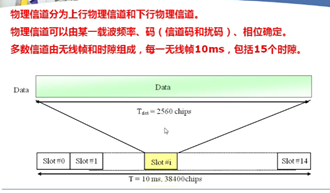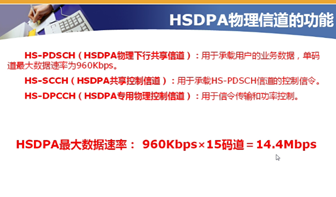(1)扩频和扩频码
4.3 Code generation and allocation
4.3.1 Channelisation codes
4.3.1.1 Code definition
The channelisation codes of figure 1 are Orthogonal Variable Spreading Factor (OVSF) codes that preserve the orthogonality between a user’s different physical channels. The OVSF codes can be defined using the code tree of figure 4.
信道化码 是OVSF 码,(保证用户的不同信道正交性)。OVSF 码 能用如图4 的代码数定义
(a)总结 OVSF 码 用于区分不同物理信道;
(b)所谓正交 是指信道码 内积为0;(按位相乘求和)
如SF=2时候: 11+1-1=0

In figure 4, the channelisation codes are uniquely described as Cch,SF,k, where SF is the spreading factor of the code and k is the code number, 0 k SF-1.
图4中 信道化码是唯一定义为 Cch,SF,k 其中SF 为扩频因子,k 是信道号码(0-SF-1)
Each level in the code tree defines channelisation codes of length SF, corresponding to a spreading factor of SF in figure 4.
The generation method for the channelisation code is defined as: 生成序列的定义


2.物理信道基础

3.84M chips/s
则1ms 是 3.84*10^3 chips, 10ms 就是38400 chips
一个slot=38400/15=2560 chips=10ms/15


(a) SCH信道(P-SCH 和S-SCH) 主要用于小区同步,
P-SCH 发送主同步码,一个时隙为周期(一个时隙发一次),实现时隙同步
S-SCH 发送主辅步码,一个帧为周期(一个帧发一次),实现帧同步
同步信道 不扩频 ,也不加扰,透明传输;
(b) CPICH:用于扰码识别
P-CPICH:信道码固定为CH-0.256(SF=256),使用住扰码加扰
P-CPICH 是其他下行物理信道功率的基准(一般其他信道功率都设置为是相对其功率的值,一旦其值增加 则其他信道功率也增加)
S-CPICH:主要用于智能能天线,一般都不用;
P-CCPCH: 用于承载系统消息SIB ,系统帧号等,信道码固定为 CH-1.256(SF=256)
P-CCPCH 和SCH 同信道, 时分复用,(也就是说SCH 信道码也是CH-1.256)

(a)DPDCH:语音,短信,流量等 业务
(b)DPCCH:解调 功率控制等信息
(c)上行时候DPDCH,DPCCH使用不同信道(OVSF不同)
(d)下行时候DPDCH,DPCCH相同信道(OVSF同)时间不同。时间复用

(a)HSDPA 的扩频因子是16 因此总共16个码道,最多分配15个给HS-PDSCH,采用,留一个给BCH,CCH,CPICH 等,16QAM 单码道速率是960 kbps
- 3GPP 25-141 Test mode
6.1.1 Test Models
The set-up of physical channels for transmitter tests shall be according to one of the Test Models below. A reference to the applicable table is made with each test.
For Tx diversity transmission, the same Test Model shall be used for both antennas. No diversity coding of the Test Models is required.
A code “level setting” of -X dB is the setting that according to the base station manufacturer will result in a code domain power of nominally X dB below the maximum output power. The relative accuracy of the code domain power to the maximum output power shall have tolerance of ±1 dB.
6.1.1.1 Test Model 1 – TM1
This model shall be used for tests on:
- occupied bandwidth;
- spectrum emission mask;
- ACLR;
- spurious emissions;
- transmit intermodulation;
- base station maximum output power.
- Total power dynamic range (at Pmax,c)
- Home base station output power for adjacent channel protection
- Frequency error (at Pmax,c)
- IPDL time mask
Due to the amplitude statistics of TM1 [2], it is sufficient to test all requirements above with TM1 regardless of the modulation schemes supported by the Node-B.
In addition, the test model is used for Error Vector Magnitude using QPSK modulation (at Pmax,c).
64 DPCHs at 30 ksps (SF=128) are distributed randomly across the code space, at random power levels and random timing offsets are defined so as to simulate a realistic traffic scenario which may have high PAR (Peak to Average Ratio).(64 个DPCH(SF=128)随机分布在码道上。模拟高峰均比情况)
Considering that not every base station implementation will support 64 DPCH, variants of this test model containing 32 and 16 DPCH are also specified. For Home base station, additional options of this test model containing 8 and 4 DPCH are also specified. The conformance test shall be performed using the largest of these options that can be supported by the equipment under test.
“Fraction of power” is relative to the maximum output power on the TX antenna interface under test.
Table 6.1: TM1 Active Channels

除非额外说明。信道的SF都为256. 例如 P-CCPCH+SCH 信道码为 1.256, Primary CPICH 信道码为1.256
Table 6.2: DPCH Spreading Code, Timing offsets and level settings for TM1
















